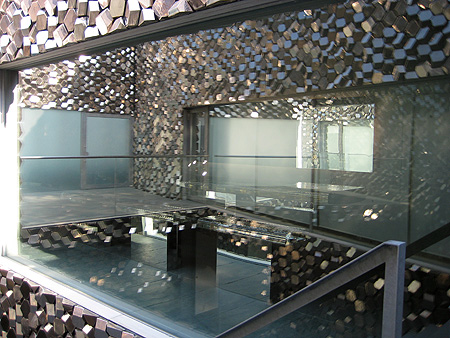A space for all things
Thursday, April 30th, 2009
After a couple of year in planning and construction, the permanent outdoor sculpture The parliament of reality by Olafur Eliasson opens in just a couple of weeks at Bard College in New York. An art commission done in collaboration between Bard’s Center for Curatorial Studies and the Luma Foundation, Eliasson’s sculpture consists of an island with a pond at its center that is accessed through a passageway turned tunnel by a latticework structure. The parliament of reality is inspired by the Icelandic Althing, an outdoor assembly considered one of the first parliamentary institutions ever. It is also inspired by the fact that it’s a sculpture made for a college, a space for constant discussion and public debate.
On Saturday, May 16, the opening day of The parliament of reality, a number of presentations and discussions by artists and scholars take place on-site Eliasson’s sculpture. Participants include: Andrea Zittel, Anri Sala, Eliasson, of course, as well as Felicity Scott (Colombia University), Molly Nesbit (Vassar College) and Peter Galison (Harvard University), among other scholars. The day before, the Human Rights Project at Bard College, which is directed by Thomas Keenan, is also hosting an event on-site. This one focuses on the use of music for torture—a “technique of interrogation and punishment by U.S. military forces and intelligence agencies.” The participant list is not confirmed yet, but knowing past programs of Keenan, it promises to be a quite eclectic and interesting group of people from different fields.
***
Some weeks ago, while in Tokyo, I had the opportunity of visiting Yu-un, a private guesthouse and museum-like space of art collector Mr. Obayashi. Yu-un, which translated to something like a place to retreat or a site of wonder, is designed by the renowned Japanese architect Tadao Ando. At the start of the project, Obayashi and Ando commissioned a handful of artists to create works on site. One of the commissions was Olafur Eliasson. Invited to create a work for the courtyard, pictured above, the artist proposed cladding the walls with a platinum-glazed version of his “quasi brick” tiles. (Eliasson first used this brick in his installation in the Dutch Pavilion of the 50th Venice Biennale in 2003.)
Andreas Eggertsen, who worked in Eliasson’s studio while this art commission of Yu-un was in production, explains that the quasi brick “is a space filling geometry based on ‘fivefold symmetry’: a mathematical description of a quasi-chaotic geometry, which was found by a physicist in the 80s. The bricks can be rotated into 6 different positions, and put together randomly they create a very complex pattern.” To read more about Yu-un, and to see better images of Eliasson’s commission other than my amateur snap shot, above, check out Lucy Birmingham’s feature article on Yu-un for Architectural Digest; the article is illustrated with photography by Robert McLeod, showing interior and exterior views of the house.


